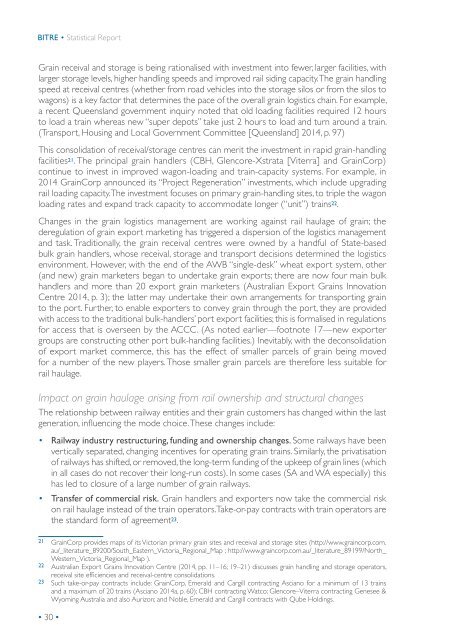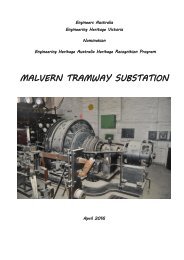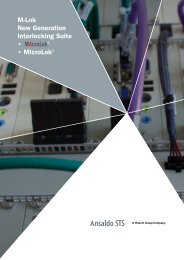mgn5pn8
mgn5pn8
mgn5pn8
You also want an ePaper? Increase the reach of your titles
YUMPU automatically turns print PDFs into web optimized ePapers that Google loves.
BITRE • Statistical ReportGrain receival and storage is being rationalised with investment into fewer, larger facilities, withlarger storage levels, higher handling speeds and improved rail siding capacity. The grain handlingspeed at receival centres (whether from road vehicles into the storage silos or from the silos towagons) is a key factor that determines the pace of the overall grain logistics chain. For example,a recent Queensland government inquiry noted that old loading facilities required 12 hoursto load a train whereas new “super depots” take just 2 hours to load and turn around a train.(Transport, Housing and Local Government Committee [Queensland] 2014, p. 97)This consolidation of receival/storage centres can merit the investment in rapid grain-handlingfacilities 21 . The principal grain handlers (CBH, Glencore-Xstrata [Viterra] and GrainCorp)continue to invest in improved wagon-loading and train-capacity systems. For example, in2014 GrainCorp announced its “Project Regeneration” investments, which include upgradingrail loading capacity. The investment focuses on primary grain-handling sites, to triple the wagonloading rates and expand track capacity to accommodate longer (“unit”) trains 22 .Changes in the grain logistics management are working against rail haulage of grain; thederegulation of grain export marketing has triggered a dispersion of the logistics managementand task. Traditionally, the grain receival centres were owned by a handful of State-basedbulk grain handlers, whose receival, storage and transport decisions determined the logisticsenvironment. However, with the end of the AWB “single-desk” wheat export system, other(and new) grain marketers began to undertake grain exports; there are now four main bulkhandlers and more than 20 export grain marketers (Australian Export Grains InnovationCentre 2014, p. 3); the latter may undertake their own arrangements for transporting grainto the port. Further, to enable exporters to convey grain through the port, they are providedwith access to the traditional bulk-handlers’ port export facilities; this is formalised in regulationsfor access that is overseen by the ACCC. (As noted earlier—footnote 17—new exportergroups are constructing other port bulk-handling facilities.) Inevitably, with the deconsolidationof export market commerce, this has the effect of smaller parcels of grain being movedfor a number of the new players. Those smaller grain parcels are therefore less suitable forrail haulage.Impact on grain haulage arising from rail ownership and structural changesThe relationship between railway entities and their grain customers has changed within the lastgeneration, influencing the mode choice. These changes include:• Railway industry restructuring, funding and ownership changes. Some railways have beenvertically separated, changing incentives for operating grain trains. Similarly, the privatisationof railways has shifted, or removed, the long-term funding of the upkeep of grain lines (whichin all cases do not recover their long-run costs). In some cases (SA and WA especially) thishas led to closure of a large number of grain railways.• Transfer of commercial risk. Grain handlers and exporters now take the commercial riskon rail haulage instead of the train operators. Take-or-pay contracts with train operators arethe standard form of agreement 23 .21 GrainCorp provides maps of its Victorian primary grain sites and receival and storage sites (http://www.graincorp.com.au/_literature_89200/South_Eastern_Victoria_Regional_Map ; http://www.graincorp.com.au/_literature_89199/North_Western_Victoria_Regional_Map ).22 Australian Export Grains Innovation Centre (2014, pp. 11–16; 19–21) discusses grain handling and storage operators,receival site efficiencies and receival-centre consolidations.23 Such take-or-pay contracts include: GrainCorp, Emerald and Cargill contracting Asciano for a minimum of 13 trainsand a maximum of 20 trains (Asciano 2014a, p. 60); CBH contracting Watco; Glencore–Viterra contracting Genesee &Wyoming Australia and also Aurizon; and Noble, Emerald and Cargill contracts with Qube Holdings.• 30 •




